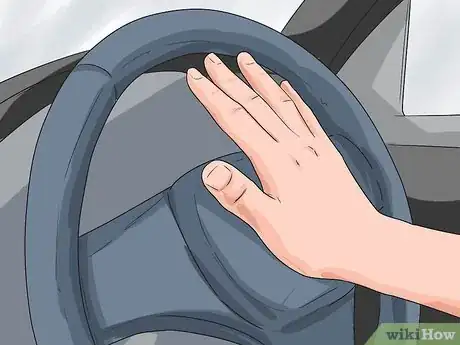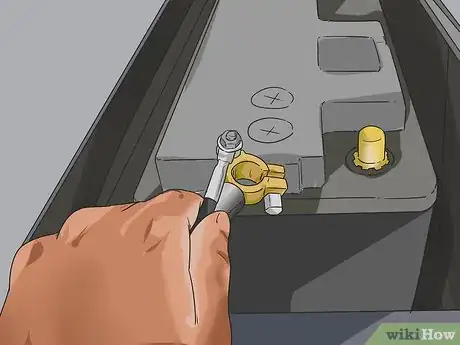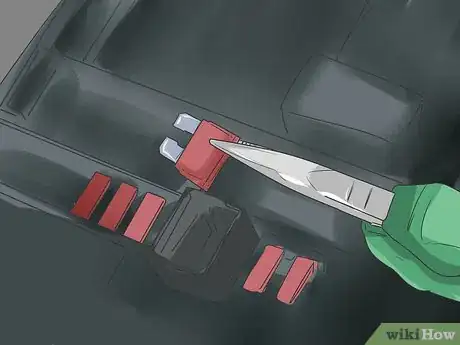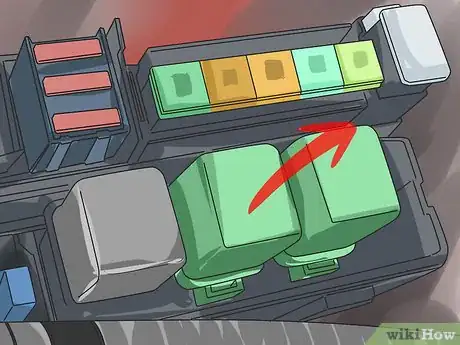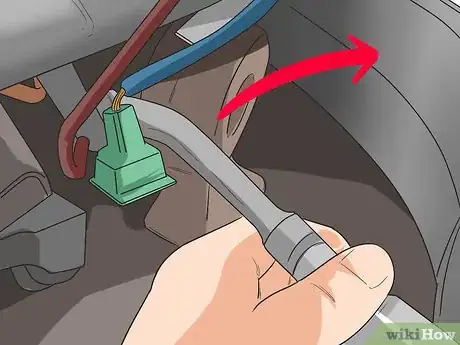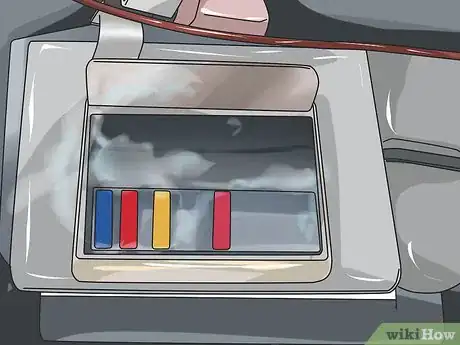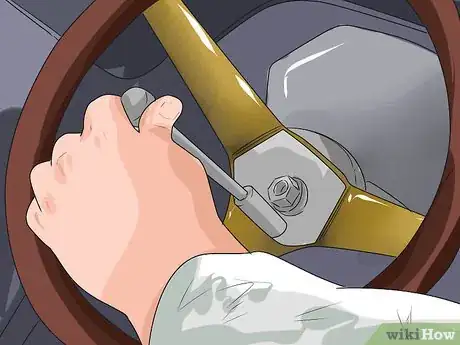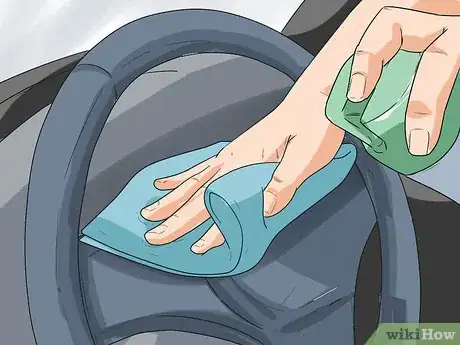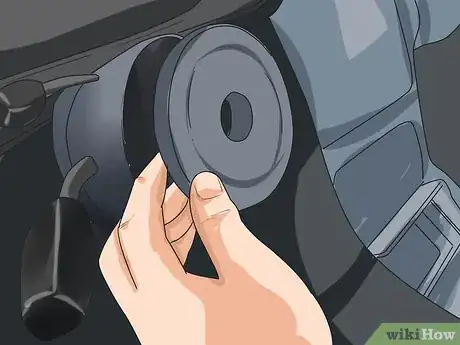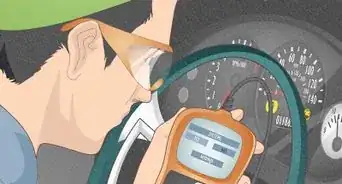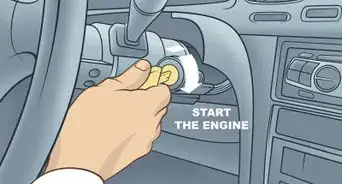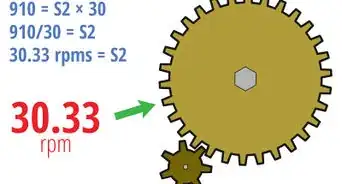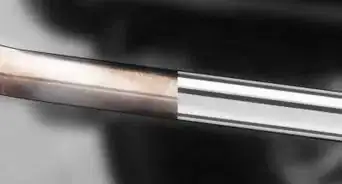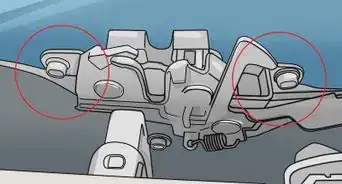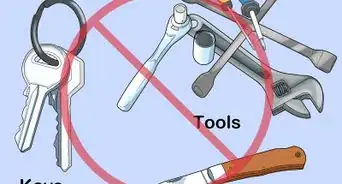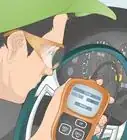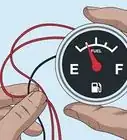This article was co-authored by wikiHow Staff. Our trained team of editors and researchers validate articles for accuracy and comprehensiveness. wikiHow's Content Management Team carefully monitors the work from our editorial staff to ensure that each article is backed by trusted research and meets our high quality standards.
There are 10 references cited in this article, which can be found at the bottom of the page.
This article has been viewed 236,647 times.
Learn more...
A jammed car horn can present an incredible nuisance. Not only will it annoy you and everyone around you, it will steadily drain your battery as well. A horn that won't shut off is usually the result of a jammed mechanical component in the steering column. Examining this area requires some caution due to the airbag located here, so it's easiest to start by disconnecting power from the horn and testing the more accessible parts of the system.
Steps
Shutting Off the Horn
-
1Push the horn several times. Pushing on your steering wheel a few times may dislodge a stuck switch in the horn's assembly.[1] You can also try twisting your steering wheel back and forth a few times.
-
2Disconnect the car battery. This will silence the horn, and if you're lucky it may reset the horn and solve the problem (although there may be an underlying issues that causes it to recur).[2] It's also a good idea to disconnect the battery before trying the steps below, to reduce the danger of electric shock or short circuits. Follow these steps to disconnect the battery safely:[3]
- Turn off the engine. (Leave it off for the steps below as well.)
- Wear insulated gloves and safety goggles. Remove all metal jewelry.
- Find a socket wrench that fits the terminal (typically ⅜ inches).
- Disconnect the negative terminal first. This typically has a - symbol and is connected to a black wire. Use caution to avoid creating a short with the wrench or wire.
- Disconnect the positive terminal.
Advertisement -
3Disconnect the fuse connected to the horn. Check your car's manual to find out where the fuse box is located. The fuse box cover or the manual should have a diagram that tells you which fuse is part of the horn's wiring. Turn off the ignition, then pry the fuse out by hand or with fuse pullers.
- If you do not have your car manual, search online for your make and model, followed by "manual" or "fuse diagram."
- The fuse box is usually located under the driver's side dash, in the driver's side doorjamb, or in the glovebox.[4] Many cars have a second fuse box in the engine compartment.
- Some models, especially older ones, run several electrical components on the same fuse as the horn. Inspect the fuse diagram so you know what else will be affected.
-
4Remove the horn relay. Most cars have a horn relay, which feeds extra current into your horn. This is usually a cube with a diagram on the side, plugged into a slot in the under-hood fuse box.[5] An inoperative relay typically stops your horn from working, but it is possible for it to jam the horn in an on position.[6] Even if the relay is not the problem, removing it should disable the horn.
- Refer to the wiring schematic on the fuse box lid or in your owner's manual to identify the correct relay.
- If your horn sounds different than usual or you do not hear the usual clicking sound when you press it, the relay is likely shorted. Replace it and try to discover the cause of the short, such as a damaged wire or water in the fuse box.
-
5Disconnect the horn itself. If your car has no relay and the horn's fuse is on the same circuit as other important components, remove the horn itself. This is located under the hood, usually behind the front grille or attached to the firewall behind the engine.[7] The horn is typically shaped like a loudspeaker or a toroid (doughnut). Disconnect the wires leading to the horn. Cover the exposed wires with electrical connectors or electrical tape to prevent a short if you plan on driving the car to an auto repair shop.
- Many cars have two horns, but these are usually attached to the same unit. Refer to your owner's manual wiring schematic if you are having trouble locating the horns.
- The battery must be disconnected while removing this part.
- Remove all jewelry and dangling clothing before reaching below the hood.
Fixing the Problem
-
1Look for moisture that could be causing a fault. This may happen after a severe rainstorm, or if your car has been power washed under the hood by yourself or your dealer. If you see any moisture in the fuse box, disconnect the battery and leave the car to dry out. Severe water buildup or corrosion may require a mechanic to repair.[8]
-
2Install an auxiliary horn button. If the switch inside your steering column is jammed, one solution is to install an auxiliary horn that bypasses this switch, available from any auto parts store. Check your owner's manual to make sure you wire it to the 12v line that powers your horn. This is best used as a temporary fix until you can get the faulty part replaced.
-
3Have an experienced mechanic remove the airbag. The remaining solutions involve the steering column, which also contains an airbag in most cars. If you do not properly deactivate and remove the airbag, it may deploy with extreme force. Some cars have a backup battery for the airbag which may allow it to deploy even when the main battery is disconnected. Do not to try this yourself unless you are confident you have the expertise to disable it safely, and you have an owner's manual to guide you.[9]
- Always disconnect the battery first and wait at least thirty minutes for the power to drain from the airbag system.
-
4Dry out water in the steering column. If there is any corrosion or moisture inside the steering column, water could be shorting your system and causing the stuck horn. Try drying it with an air compressor, and spraying damp parts with an electrical cleaner. Reassemble the steering column once it is dry, and the horn may work again.
-
5Replace the switch or clock spring. If the electrical parts are all functional, the horn switch under the steering wheel may be jammed. Another possibility is a broken clock spring: the coil that winds and unwinds as you turn the wheel to maintain the electrical connection. The clock spring is especially likely to be the problem if your airbag warning light is on, or if you have noticed other issues with electrical components on your steering column.[10] You may wish to have a mechanic install the clock spring.
Community Q&A
-
QuestionHow do I disconnect my car horn?
 Community AnswerThe easiest way to do this is to pull the horn fuse, usually located in the fuse panel under the steering wheel. Look for a cover on the underside of the dashboard; when you remove it, you should see a grid of small, colorful plastic rectangles with numbers printed on them. Those are fuses. Next, look in your car's owner manual for the section about fuses. There should be a diagram and chart showing you which fuse does what. Find the one for the horn, and pull it out. Some cars come with a fuse puller, usually clipped into the fuse panel cover. If your car doesn't have one, needle-nose pliers will work. Please note that your car may not pass inspection if the horn doesn't function.
Community AnswerThe easiest way to do this is to pull the horn fuse, usually located in the fuse panel under the steering wheel. Look for a cover on the underside of the dashboard; when you remove it, you should see a grid of small, colorful plastic rectangles with numbers printed on them. Those are fuses. Next, look in your car's owner manual for the section about fuses. There should be a diagram and chart showing you which fuse does what. Find the one for the horn, and pull it out. Some cars come with a fuse puller, usually clipped into the fuse panel cover. If your car doesn't have one, needle-nose pliers will work. Please note that your car may not pass inspection if the horn doesn't function. -
QuestionCan I remove the horn fuse and leave it out on my 2001 Nissan Sentra?
 Community AnswerYes, but your car might not pass inspection without a working horn.
Community AnswerYes, but your car might not pass inspection without a working horn.
Warnings
- Don't disconnect any fuses without turning the car's engine off first.⧼thumbs_response⧽
- It's best to disconnect the battery before conducting any repairs on the wiring, fuses, or any other part of the electrical system.⧼thumbs_response⧽
- Driving without a working horn is illegal in most if not all areas.[11] If you disconnect your horn, get it repaired as soon as possible.⧼thumbs_response⧽
Things You'll Need
- Safety goggles
- Insulated gloves
- Owner's manual
- Fuse pullers
- Electrical tape or wire connectors
References
- ↑ http://car.tips.net/T004714_Your_Car_Horn_wont_Stop_Blowing.html
- ↑ http://car.tips.net/T004714_Your_Car_Horn_wont_Stop_Blowing.html
- ↑ https://www.yourmechanic.com/article/how-to-remove-a-car-battery
- ↑ http://www.dmv.org/how-to-guides/fuse.php
- ↑ https://www.yourmechanic.com/article/how-to-repair-a-car-horn-by-mia-bevacqua
- ↑ https://www.yourmechanic.com/article/symptoms-of-a-bad-or-failing-horn-relay
- ↑ http://knowhow.napaonline.com/how-to-fix-a-car-horn-in-4-steps/
- ↑ https://www.corvetteforum.com/forums/c6-corvette-general-discussion/2512019-horn-will-not-turn-off-need-some-help.html
- ↑ http://www.popularmechanics.com/cars/how-to/a95/1272506/
About This Article
To shut off a jammed horn, first try pushing the horn and twisting the steering wheel a few times. If that doesn’t work, disconnect the car battery to silence the horn. Should the problem recur when you reconnect the battery, disconnect the fuse connected to the horn and remove the horn relay. The fuse box is usually located under the driver’s side dash, in the driver’s side door jamb, or in the glovebox. The horn relay is usually a cube with a diagram on the side, plugged into a slot in the under-hood fuse box. If your car doesn’t have a horn relay or the horn’s fuse is on the same circuit as other important car components, disconnect the horn itself. It is typically shaped like a loudspeaker or doughnut, and located under the hood behind the front grill or attached to the firewall behind the engine. For more information on how to address problems like moisture that might be causing a jammed horn, read below!
